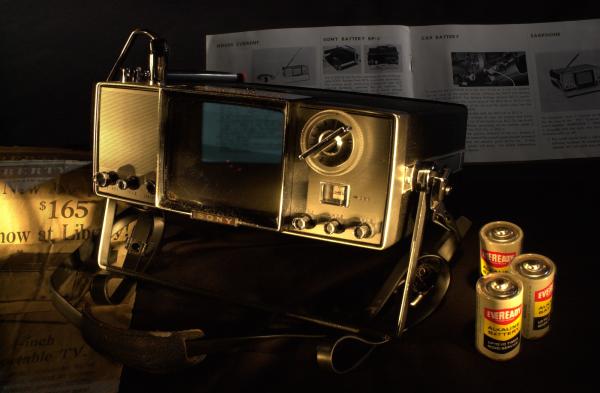
Expected date of Museum opening: September 12, 2000 Preferably this will be a travelling exhibit to be shown at the Smithsonian Museum in the United States, and the Science Museum (e.g. Wellcome Wing, where WearComp was shown) in the U.K. (10k secured for the budget to design and build 1 time; if good enough to travel we could increase funding to make it travelable.) Possible titles: 1. Eye am everywhere (Eye am everywear) 2. TV to go 3. Eye am a camera 4. Television goes out of the livingroom (and into the street, world, ...) 5. Eye on the run Carpenter shop at CHUM City to build raised platform for approximately twenty mannequins, in conjunction with in-house architects. Previous exhibits at the Stedelijk Museum of Modern Art in Amsterdam (http://wearcam.org/stedelijk/ and http://wearcam.org/lvac/index.html may be consulted as examples of how to lay out the exhibit). The mannequins will be in a central area, facing outwards, so that they can all be viewed clearly, but the set will be designed to protect senstive small artifacts from being damaged or stolen. Accordingly, a raised central "off limits" space would be preferable, wherein it could be viewed from all-around. "Carp Shop" (Carpenters) to be notified that there is a project "coming down the pipe". As we move toward television through the Internet, the distinction between analog and digital, and between standards such as NTSC (PAL or SECAM) and VGA will disappear. Thus if it has not come to pass already, it will soon come to pass, that a VGA computer display screen is as much a television set as is a display screen that accepts an NTSC signal, or the like. Mannequins are to be painted mid grey (photographic grey), wherein mid grey is defined as reflecting 18% of the incident light regardless of wavelength (e.g. the color of the standard video/photographic "grey card" used in the television industry). Mannequins are to be dressed in black clothing (black cloth being symbolic of the photographic past and of the video camera which is itself a descendant of the camera obscura). Mannequins in a variety of poses are to be selected, suitable for emphasizing the portable, mobile, and wearable nature of television in the modern age of the nomadic. Mannequins are to be secured to platform with standard butt rods, screwed to the platform, and, additionally, both feet are to be firmly screwed to the platform. All items in the exhibit should be in working condition. Preferably there would be detailed technical information about each piece. An important aspect of the early days of television was the availability of full schematics and full disclosure of the principles of operation of the TV sets. This was the "golden age" of television. The common thread running through the exhibit is portability, not just in transport, but in actual operation. Accordingly, battery operation is an important element in the selection of the pieces for the exhibit. The exhibit will include the following pieces, which are either part of the MZTV collection, part of the curator's own collection, or to be acquired for the exhibit. Pieces denoted "M" are already owned or acquired by MZTV. Pieces denoted "C" are already owned or acquired by the curator (Prof. Steve Mann). Pieces denoted "A" are to be acquired from other sources. Selection criteria are based on those pieces that show a key inventive step with respect to the prior art of the era. Thus, for example, we have the world's first portable TV, the world's first battery powered TV, the world's first wearable TV, and so on. M: Suitcase TV (e.g. the 1947 Motorola suitcase TV) to exemplify an era when television was uncommon enough that those who wanted to watch TV on the go, would bring their own TV with them. Related articles, such as Hallicrafters selectable picture size TV. Radio-Electronics, March 1949, would also compliment this piece. The suitcase is much more symbolic of travel than merely having a handle on the top of the TV set, as was later seen on many televisions. M: 1959 Philco Safari, solid state lightweight battery powered television. The one inch CRT with magnifier made low power and therefore battery operation practical. A 7.5 volt rechargeable battery was housed within the TV set, inserted in through the bottom. This was the world's first battery operated televsion set. M: 1965 SONY TV4-203UW; World's first wearoperable TV. This battery powered TV had an antenna built into a neckstrap so that it was wearoperable (could be worn while in use). A four inch screen provided direct viewing without the need for a magnifier. It ran on 12-13.5 volts from nine 1.5 volt "C" size batteries inserted into the back of the set, or from a car battery; one of the optial accessories was a car mount antenna. M: 1972 Panasonic TR-001, Palm sized TV. M: 1980, Clive Sinclair, World's first pocket TV. 2 inch CRT. Originally sold for $300 U.S.. C: 1981: World's first wearable computerized TV station. 1.5 inch cathode ray tube running at 5000 volts. 6502 microprocessor. A: 1982: World's first wristwatch TV (Seiko-Epson built a prototype wrist TV in 1982) See: http://www.homestead.com/tropicalmontys/tvwatch.html (a web site dedicated to Seiko's 1982 television watch). SEIKO model RT01A Wrist-Watch TV Circa 1980, Pulled from sales due to the high cost of $495.00 and poor performance. LCD was not backlit (poor viewing by the ambient light). C: 1985: The Wearable videographic/photographic apparatus of the 1970s and early 1980s gave rise to a new genre of photo/video in Toronto. Following an exhibit at Night Gallery, 185 Richmond Street, Toronto, in the Summer of 1985, Cybernetic television was born and evolved into what would later become the first Internet television station. C: 1990: Sony WatchCAM, a portable television for CCTV use. A unique reversed CRT directs an electron beam at a reflective rather than transmissive phosphor screen, such that the viewer is looking at the tube from the inside. The result is a unique folded CRT design that is sleek and slender. For picture, see http://wearcam.org/mztv/watchcam.jpg C: 1992: Virtual Vision manufactured a complete wearable battery operated colour television system, including a wearable tuner connected to a 0.7 inch LCD screen in eyewear with a magnifying prism. The innovative design allowed the wearer to watch television while walking around. C: 1992: N1NLF-TV, a complete wearable television production studio. Online and connected, with wireless communication, the new photographic videographic genre emerges. C: 1994: World's first Internet television station (N1NLF-TV) goes on the World Wide Web. First roving Web reporter. The complete wearable television production studio transmits continuously to the World Wide Web, to define a new genre of electronic newsgathering. C: 1995: Virtual I/O wearable NTSC TV display intended for watching TV or playing video games. C: 1996: World's first covert eyeglass based television. A fully functional colour TV set was concealed in ordinary looking eyeglasses. The eyeglasses also contained a camera system, for use with a television production studio concealed underneath ordinary clothing. C: 1997: ShootingBack, world's first documentary video on the Internet. Sony to provide the playback equipment for a showing of this documentary, and a showing of some of the early N1NLF-TV material. C: 1997: stereo television for Virtual Reality systems. Two miniature (1 inch) CRTs, each operating at 13,000 volts, provide a high brightness image. A field sequenced shutter alternately displays red, green, and blue images to create a natural television image completely free of the pixel artifacts that are commonly found on most colour television sets. This television set, the VR5, was sold commercially for around $20,000 U.S., by Virtual Research. C: 1998: World's first fully functional wristwatch videoconferencing system, later presented at ISSCC 2000 and featured on the cover of Linux Journal. C: 1998: EyeTap television: eye itself functions as both a TV camera and TV. from broadcast TV, to CCTV, to nearby tv, to zero distance TV, is it TV? whether PAL, SECAM, NTSC, or VGA, is it still TV? local station of the computer (Apple ][ TV...) to the eyecup viewfinder. Additional pieces to be provided by curator: =Collection of miniature Cathode Ray Tubes (CRTs) used for camera viewfinders, from Porta Pak to modern camcorders, to virtual reality, etc. =Various other "Surveillance Situationist" pieces to be included as space and time permit, as per assessment of audience profile and expected level of audience sophistication. Proposal, graphics, photos, etc., to be couriered to 299 Queen St. West, MZTV Museum, M5V 2Z5 care of Mike Adams Mike Adams fax = 416.762-9504

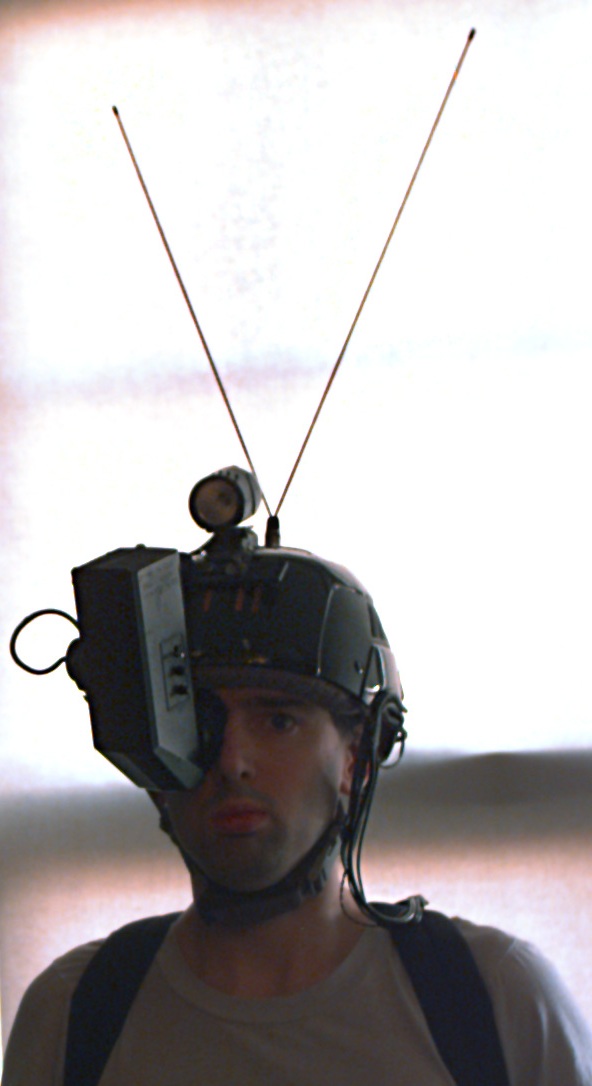
A mid 1980s version of Mann's "WearComp" invention:

A 1970s version of the "WearComp" apparatus. Mann's
early photographic inventions bear many similarities to current-day
WearComp systems:
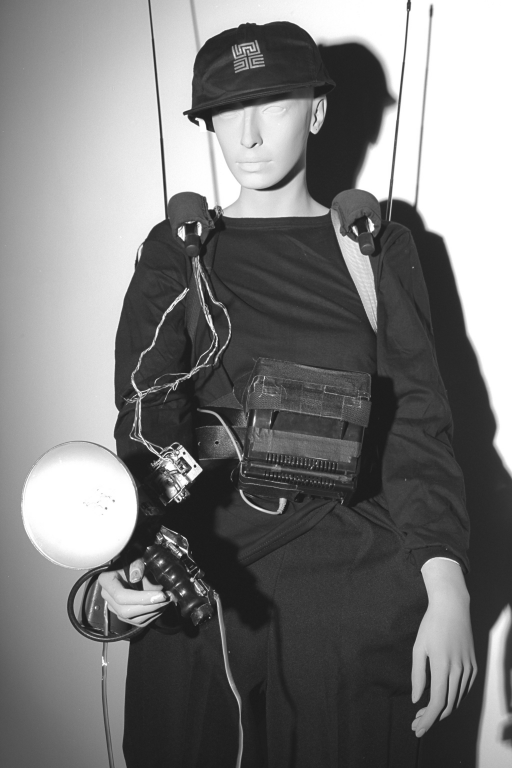
Various embodiments of "maybe camera",
and "probably camera"
explore issues of surveillance in society.
This "ShootingBackPack" re-situates the ubiquitous but
mysterious
ceiling domes of wine-dark
opacity  in a disturbing and disorienting
fashion by placing them upon the backs of otherwise
vanquished (surveilled) individuals as instruments of personal
empowerment and personal safety.
in a disturbing and disorienting
fashion by placing them upon the backs of otherwise
vanquished (surveilled) individuals as instruments of personal
empowerment and personal safety.

One of the pieces on display in the List Center
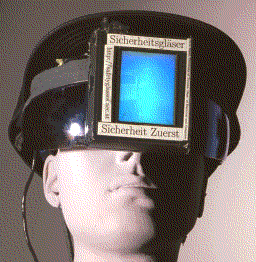
was also used in
the week long performance piece I did at
Ars Electronica, along
with my invited plenary lecture in the Ars Electronica Symposium.
The performance was called "Sicherheitsglaeser", and some images
can be revisited at:
http://n1nlf-1.eecg.toronto.edu/sicherheitsglaeser/
Shortly afterwards, the rig traveled (on my body) back to the United
States, to ISEA:
http://n1nlf-1.eecg.toronto.edu/isea97/

I do not talk to strangers.
Therefore you must slide a government-issued ID
card through the slot on my head if you want to talk to me.
These SAFETYGLASSES prevent me from seeing or hearing you until you
identify yourself!
Until you provide positive ID, the camera and microphones on my head will
not be connected to my head mounted display set.
Your time is very important to me, so please wait for my next available moment!
If you would like to try to sell me a new product, press 1.
If you would like to ask me to fill out a form, press 2.
If you would like to show me an advertisement, press 3, and
slide your credit card through my
slot to purchase my attention.
For quality-control and training purposes, this conversation may be
recorded or monitored.
If you would like to inform me that photography is not permitted on your
premises, press 9, and wait for my next available moment.
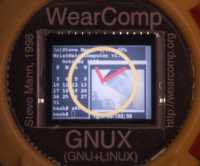
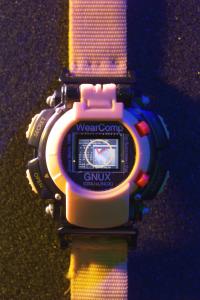
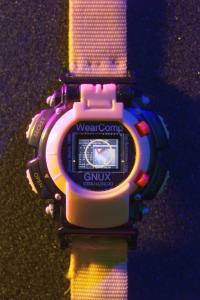
ISSCC: 'Dick Tracy' watch watchers disagree By Peter Clarke EE Times (02/08/00, 9:12 p.m. EST) SAN FRANCISCO -- Panelists at a Monday evening (Feb. 7) panel session at the International Solid State Circuits Conference (ISSCC) here failed to agree on when the public will be able to buy a "Dick Tracy" style watch for Christmas, with estimates ranging from almost immediately to not within the next decade. Steve Mann, a professor at the University of Toronto, was hailed as the father of the wearable computer and the ISSCC's first virtual panelist, by moderator Woodward Yang of Harvard University (Cambridge Mass.). ... Not surprisingly, Mann was generally upbeat at least about the technical possibilities of distributed body-worn computing, showing that he had already developed a combination wristwatch and imaging device that can send and receive video over short distances. Meanwhile, in the debate from the floor that followed the panel discussion, ideas were thrown up, such as shoes as a mobile phone -- powered by the mechanical energy of walking, and using the Dick Tracy watch as the user interface -- and a more distributed model where spectacles are used to provide the visual interface; an ear piece to provide audio; and even clothing to provide a key-pad or display.